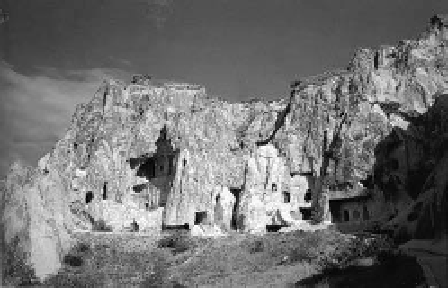Environmental Engineering Reference
In-Depth Information
Province. a great many studies have been carried
out on the central anatolian volcanism (keller,
1974, Batum, 1978, Besang, et al., 1977, Pasquaré
et al., 1988, Bigazzi et al. 1993, Druitt et al., 1995,
le Pennec et al., 1994, Froger et al., 1998,
kürkçüoğlu, 1988, Toprak 1998, Şen et al., 2003).
The central anatolian volcanism is influenced by
the intercontinental convergence associated with
collision of the african plate with the eurasian plate
and produced many polygenetic volcanoes, such
as hasandag, erciyes, Melendiz, keciboyduran;
monogenetic volcanoes, such as Golludag as
domes, acigol, cora as maars and several hundreds
of scoria cones and extensive ignimbrite sheets
(Gencealioglu & Geneli, 2008). This volcanic belt
extends about 300 km along a ne-sW direction.
Mount erciyes is situated in the eastern part of this
belt. The related geological map of Mount erciyes
and its calderas, domes and cones are shown in
Figure 3. The volcanic evolution of Mount erciyes
is divided into two stages named as kocdag and
new erciyes (kürkçüoğlu, 1998 and Şen, 2003).
The stratigraphical column is given in Figure 3.
kocdag is mainly composed of lava flows of alka-
line basalt, andesite and basaltic andesites. They
constitute the eastern flank of the Mount erciyes
volcanic complex. The first explosive activity is
the ignimbrite eruption, 2.8 Ma ago (innocenti
et al., 1975) and this eruption was followed by a
caldera collapse. The new erciyes stage represents
different basaltic, andesitic, dacitic, rhyodacitic
lava generations and associated pyroclastics. The
volcanic products are related to central and adven-
tive monogenetic vents (domes and cones). The
last eruption dated 0.083 Ma (notsu et al., 1995)
corresponds to the fourth dacitic lava generation
rhyodacitic dome and debris avalanche deposits is
the best known and most recent products of the
volcano (kürkçüoğlu, 1998).
Figure 1.
Pasabaglari chimneys (Demir 2008).
Figure 2. a group of churches carved into rock at
Goreme (Umar, 1998).
The carved grottoes reflect Byzantine archi-
tecture, style and painting. Most of the dwellings and
chapels date from the 10th-13th centuries. (sari &
Özsoy 2009). easy carving and thermal isolation
properties of the soft tuffs have been the main rea-
sons for the extensive multi-purpose underground
settlement in the cappadocia region from past to
present (aydan, 2003).
3
consTRUcTion MaTeRials
RelaTeD To The MoUnT eRciYes
The rocks of Mt. erciyes, andesite, ignimbrite and
basalt were widely used as construction materials
in low storeyed buildings and especially in histori-
cal monuments in the past. however, nowadays
andesite, basalt, ignimbrite and different colored
tuffs are used for decorative purposes and pav-
ing. additionally basalts are used as concrete and
road construction aggregate. The other rocks of
Mt. erciyes are pumice and perlite which are used
making light weight bricks and concrete. in the
cappadocia Volcanic Province there are two hun-
dred and five quarries related to volcanic rocks
2
a BRieF GeoloGY oF MoUnT
eRciYes
Mount erciyes is the largest stratovolcano in the
eastern part of the central anatolian Volcanic















